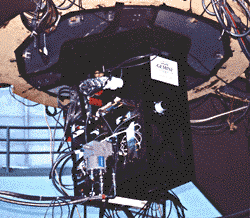Gemini
The UCLA twin-channel (Gemini) camera is the only one of its kind in the world. The detectors are both 256 x 256 pixel arrays. In the short-wavelength channel (1-2.4 microns) we use the Rockwell International NICMOS3 HgCdTe array and in the long-wavelength channel (2 - 5 microns) we employ the indium antimonide (InSb) array made by Hughes-Santa Barbara Research Center (SBRC, Goleta, Ca.). NOTE: the 2-micron K band can be directed to either channel for cross calibrations.
First Light was obtained in June 1993.
Among the unique features of this instrument are:
- Compact electronic control system based on Transputers
- Cryogenic system based on a closed-cycle refrigerator
- Multiple optical configurations with full automation
- User-friendly, menu-driven software with instant, side-by-side display of images obtained by both channels
- Excellent sensitivity
- Two wavelength channels selected by a dichroic beam-splitter
- A ten-position filter wheel for each channel and provision for a grism
Filters include Br alpha, Br gamma, S(1) 2.122, CO bandhead, 3.3 microns - Cold aperture wheel with 77K slit and coronagraph occulting spot. Cold Lyot stop.
Technical Descriptions:
I.S. McLean et al. 1993, in Infrared Detectors and Instrumentation, ed. A. Fowler (Bellingham:SPIE), 513.
I.S. McLean et al. 1994, in Instrumentation in Astronomy VIII, eds. D.L. Crawford and E.R. Craine (Bellingham:SPIE), 457.
The image scale on the UCO 3-m Shane Telescope at Lick Observatory, Mt. Hamilton, Ca., is 0.675 arcsecond/pixel giving an excellent field of view of almost 3x3 arcminutes for infrared surveys.
Options include: direct infrared imaging using broad and narrow spectral bands, infrared spectroscopy (R = 550), infrared polarimetry (both in imaging and spectroscopic mode), stellar coronagraphic imaging.
The spectroscopic mode is achieved by equipping each beam of the two-channel camera with grisms. A grism is a (small) right-angled prism with a transmission diffraction grating deposited on the hypotenuse. The grisms are located in the filter wheel and provide a spectrum of a source located in the entrance slit. An entrance slit of fixed width (2 pixels) can be selected instead of an open aperture.

